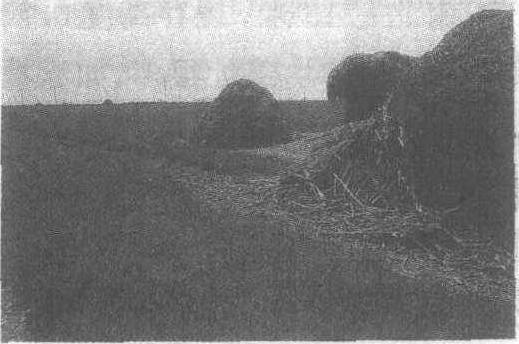丰镐遗址
是周文王建立的丰邑遗址和周武王建立的镐京遗址的合称。位于陕西省西安市西南12公里处的沣河两岸。丰在河西,镐在河东,面积10平方公里。年代约为公元前11世纪至公元前771年,分早、中、晚三个时期。丰镐遗址的遗迹有建筑遗存、窖穴、水井和墓葬。遗物有石器、铜器、陶器、骨、角、蚌器,原始瓷器及甲骨等。建筑遗存包括夯土基址、陶水管、板瓦及小型居址。其中陶水道长17米,两端口径分别为0.32米和0.22米,显而易见是为便于嵌套。板瓦带瓦钉或瓦环,表面还饰有绳纹,它的出现是建筑材料上的重大突破。发现的20余座小型居址分土窑式和半地穴式两种,后者平面又呈方形、长方形和圆形三种。有学者推测,这种穴居和半穴居状态,可能是周人“陶覆陶穴”生活习俗的反映。窑穴和水井多分布在居址附近,窖穴多为圆形袋状,出土有陶器。水井深9米,分方、圆两种,井壁有对称的脚窝。已发现的墓葬,附葬的车马坑、马坑和牛坑约400座。墓葬多为长方形土坑竖穴,车马坑有方形、扇形、长方形3种。马坑以长方形竖穴居多数,牛坑为圆形或长方形。在沣河西岸喀省庄的一处车马坑中,曾发现一辆驾四马作战用的戎车和一辆驾二马乘坐的轺车。前者车马全部以青铜为饰,工艺相当考究。在铜器窖藏中,发现了很多西周末年的青铜礼器,如张家坡发现的一个窖藏内就出土了53件铜器,其中有铭文的占32件,马王村一个窖藏内出土25件铜器,有铭文的达10件,又如新旺村出土的盂铭文记载了周王内宫后妃选宫人、宫婢之事。这些铭文为研究西周王朝与方国的关系、宫廷制度等提供了资料,具有重要的学术意义和极高的历史艺术价值。出土的遗物中,石器有斧、锛、凿、铲、锤等生产工具,磨石、纺轮等生活用具和大理石质的装饰艺术品。其中锤斧是周文化的代表性传统器物。陶器有鬲、罐、簋、豆、尊、瓮、盂、圈足盘、甑、甗、等。根据器形和特征,可分早、中、晚三期。骨、角、蚌器有刀、镰、针、锥、网坠、笄等生产工具和生活用具,还有骨雕马头等。原始瓷器和铜容器多出土于窖藏。对发现的两片带刻字的卜骨内容,尚未有定论,有的学者认为其应是易卦中的卦象,另有人认为是已经失传的文字。丰镐遗址是全国重点文物保护单位,有关其发掘情况,已由中国科学院考古研究所编成《沣西发掘报告》于1962年由文物出版社出版。

丰镐遗址
丰镐遗址,即西周都城丰京和镐京遗址,在西安市西南25公里长安县的沣河两岸。据史料记载公元前11世纪,周文王末年把国都从周原迁到沣河西岸,建立了丰京(现长安县客省庄、张家坡一带)。周武王灭商后,在沣河东岸建立镐京(现长安县斗门镇附近)。丰镐两个都城隔河相望,面积达88平方公里,都城规模相当宏伟。西周末年,周平王被迫迁都洛邑,丰镐京城从此败落不堪。
1955年,经考古人员对此地发掘,发现该城遗存有廊院式宫殿建筑群、手工业作坊、居民区和墓葬群,以及为奴隶主殉葬的车马坑等,出土了石器、陶器、骨器、青铜器和甲骨文等大量珍贵文物,对研究西周社会具有重要意义。1961年3月经国务院批准将此遗址列为全国重点文物保护单位。
丰镐遗址
全国重点文物保护单位。位于县西北沣河两岸。丰即周文王所建丰邑,在沣河西岸;镐即周武王所建镐京,在沣河东岸。合称丰镐,为西周政治、经济、文化中心。遗址范围,包括客省庄、马王村、张家坡、新旺村、冯村、洛水村、普渡村、斗门镇、昆明池故址一带,总面积逾10平方公里。1933年开始勘查发掘,延续至今。《周礼·考工记》:“匠人营国,方九里,旁三门,国中九经九纬,经途九轨,左祖右社,面朝后市。”由此可知丰镐城建布局井然有序。今马王村、洛水村一带,发现一处宫殿遗址,有泄水用陶制管道、板瓦等大量建筑构件。还发现20座土窑式、半穴式平民居址,附近多有窖穴、水井遗址。客省庄发掘出的车马坑中,出土有驾四马戎车、驾两马轺车各一辆,戎车驾马全部以青铜为饰,工艺考究。现已发现的墓葬及祔葬的车马坑、马坑、牛坑达400余处。另有众多的埋葬青铜器窖藏,出土青铜器近百件。仅张家坡一窖藏中即有青铜器53件,其中32件有铭文;马王村一窖藏有青铜器25件,其中10件有铭文。所记内容为西周王朝及方国重大史实,具有极高的历史价值。遗址出土的青铜器造型精美,装饰华丽,是极为珍贵的文物艺术精品。
丰镐遗址
西周文王之丰邑和武王之镐京遗址。位于陕西西安附近的沣河两岸,河西为丰,河东为镐。面积10多平方公里。为西周政治、经济、文化中心。1933年开始调查,1949年后多次发掘。发现夯土建筑遗址,有铭文铜器墓及附葬车马坑、数批铜器窖藏,以及铜、石、陶、骨、角、蚌器、原始瓷器等遗物。具有先周、西周早、中、晚期的特征,证实了该遗址的年代。
丰镐遗址
位于今沣河两岸的户县秦渡镇和长安县客省庄一带。约在前11世纪,周人把活动中心由岐山迁移到关中平原沣河流域。文王姬昌、武王姬发先后在沣河以西和以东建立了丰京、镐京。丰、镐成为当时全国政治、经济、文化的中心。丰京遗址中,先后发现了7个周代车马坑和一些周墓,出土一批青铜器和其它遗物。镐京遗址中,不断发现有青铜器随葬的墓葬。1980年,出土的周宣王十六年(前812)至二十二年(前806)间的多友铜鼎,铭文275字,记述了周宣王弟多率军征讨𤞤狁的战绩。
丰镐遗址
周文王所建丰邑与周武王所建镐千米的沣河两岸。丰在河西,遗址范围包括客省庄、马王村、张家坡、大原村、冯村、曹家寨、西王村一带,面积约6平方千米。镐在河东,遗址范围包括昆明池故址以北的洛水村、泉北村、普渡村、斗门镇一带,面积约4平方千米。年代约为前11世纪~前771年。
对遗址的调查始于1933年,而正式进行考古发掘则在中华人民共和国成立后。比较重要的发掘工作有: 1954年在普渡村发掘一座穆王时期的 “长甶墓” ,墓中出土的3件甬钟,是目前发现的年代最早的一组编钟。1955年,在客省庄清理西周墓葬51座。1956年~1957年,发掘沣西张家坡西周居住址和墓地。1959年~1963年,在马王村发现两处夯土台基,为探索丰邑的中心提供了线索; 另在沣东洛水村发现西周的夯土台基和板瓦、“白灰面” 墙建筑遗存等,为探寻镐京的中心提供了线索。1962年,出版了考古学专刊 《沣西发掘报告》 ,成为西周考古的分期标尺。此外,在马王村、张家坡等地发现数批窖藏铜器。参见 “长安铜器窖藏” 。
历年发掘的墓葬及附葬的车马坑、马坑和牛坑约400座。多为长方形土坑竖穴墓,流行单人仰身直肢葬。早期墓有殉人,一般1人,多则殉3人。随葬品绝大部分是陶器,只有少数墓随葬铜器。其中西周早期墓随葬陶器主要是鬲、簋、罐3种器形,西周晚期墓的随葬陶器主要是鬲、盂、豆、罐4种。另在张家坡发现一处被认为属周人的遗存,为研究先周文化提供了重要材料。在沣西张家坡一带,发现有不少西周时期的车马坑,经发掘和清理的已有10多座。车马坑有方形、扇形、长方形3种。前两种都埋1车2马,后一种中埋2车4马、2车6马或3车8马。每个车马坑大都有一名殉葬的舆夫。有几座车马坑保存完好,对于了解西周的车制和各种马具是重要的参考资料。马坑多长方形竖穴,内埋马2匹。牛坑为圆形或长方形,内埋牛1头。该遗址1961年被国务院确定为全国重点文物保护单位。